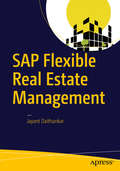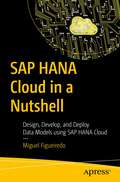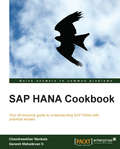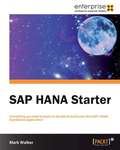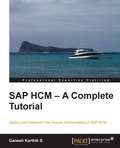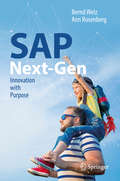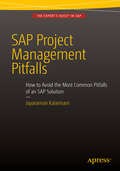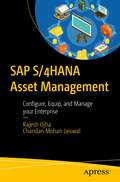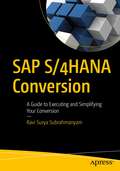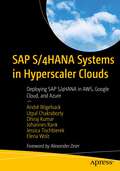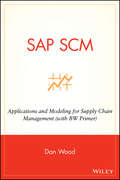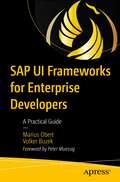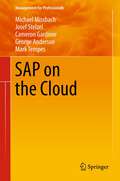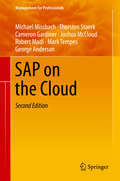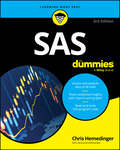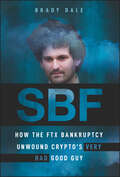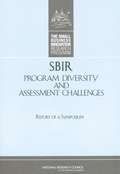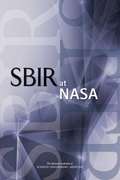- Table View
- List View
SAP Flexible Real Estate Management
by Jayant DaithankarLearn SAP's real estate management integrated solution to effectively manage the real estate portfolio at your organization. You will configure SAP REFX for business scenarios covering solutions from master data to financial posting and reporting. You will address all phases of the real estate life cycle, including real estate acquisition or disposal, portfolio management, and property and technical management. To succeed in today's global and highly competitive economy, asset optimization in real estate management has become a strategic task. Organizations need to ensure insight into their property portfolio to make informed decisions, improve portfolio performance, and reduce compliance costs. Sophisticated solutions are needed to manage changing consumer demands and the global workforce as well as information management, compliance adherence, and leasing and property management. SAP Flexible Real Estate Management by Daithankar is a full-featured book that integrates REFX with Controlling (CO), Plant and Maintenance (PM), CRM, SAP AA (ssset accounting), and SAP PS (project systems). You will refer to real-world, practical examples to illustrate configuration concepts and processes, and learn in an interactive, hands-on way through the use of screenshots, menu paths, and transaction codes throughout the book. What You Will Learn: Understand the SAP REFX Solutions landscape and industry best practices for SAP REFX implementation Understand how processes are supported by SAP REFX Configure SAP REFX Integrate REFX with other modules Who This Book Is For: CIOs/CEOs of organizations with real estate portfolios, SAP REFX purchasing decision makers, SAP REFX pre-sales teams, SAP REFX implementation/AMS consultants
SAP HANA Cloud in a Nutshell: Design, Develop, and Deploy Data Models using SAP HANA Cloud
by Miguel FigueiredoThis book introduces SAP HANA Cloud and helps you develop an understanding of its key features, including technology, architecture, and data modeling. SAP HANA Cloud in a Nutshell will help you develop the skills needed to use the core features of the completely managed and in-memory cloud-based data foundation available in the SAP Business Technology Platform. The book covers modern modeling concepts and equips you with practical knowledge to unleash the best use of SAP HANA Cloud. As you progress, you will learn how to provision your own SAP HANA Cloud instance, understand how to work with different roles, and work with data modeling for analytical and transactional use cases. Additionally, you will learn how to pilot SAP BTP Cockpit and work with entitlements, quotas, account structure, spaces, instances, and cloud providers. You will learn how to perform administration tasks such as stop and start an SAP HANA Cloud instance and make it available for use.To fully leverage the knowledge this book offers, you will find practical step-by-step instructions for how to establish a cloud account model and create your first SAP HANA Cloud artifacts. The book is an important prerequisite for those who want to take full advantage of SAP HANA Cloud. What You Will Learn Master the concepts and terminology of SAP Business Technology Platform (BTP) and SAP HANA Cloud Understand the key roles of an SAP HANA Cloud implementation Become familiar with the key tools used by administrators, architects, and application developers Upgrade an SAP HANA Cloud database Understand how to work with SAP HANA Cloud modeling supporting analytical and transactional use casesWho This Book Is ForSAP consultants, cloud engineers, and architects; application consultants and developers; and project stakeholders
SAP HANA Cookbook
by Chandrasekhar Mankala Ganesh Mahadevan V.An easy-to-understand guide, covering topics using practical scenarios and live examples, and answering all possible questions.If you are a solution architect, developer, modeler, sales leader, business transformation managers, directors, COO, or CIO; this book is perfect for you. If you are interested in other technologies and want to jump-start into SAP, this book gives you the chance to learn SAP HANA. Basic knowledge of RDBMS concepts enough is to get you started.
SAP HANA Starter
by Mark WalkerWritten as a practical guide, SAP Hana Starter will show you all you need to know to build your first reporting application utilizing SAP's new in-memory database technology. SAP HANA Starter is aimed at SAP consultants and users of competing database technologies, as well as anyone curious as to what all the fuss concerning SAP HANA is about. No previous SAP ERP, BW, or database programming experience is necessary, though notions of how SQL and table joins work will be advantageous. Access to a SAP HANA box is necessary to follow the examples locally.
SAP HCM - A Complete Tutorial
by Ganesh Karthik SThis book is a simple tutorial guide with practical issues and their solutions, aimed at enabling readers to implement the various features of the SAP HCM module. If you are familiar with ERP products, and would like to leverage knowledge and fine-tune your configuration skills, then this book is for you. This book is aimed at readers who want to learn about SAP HCM and its most popular functionalities.
SAP Next-Gen: Innovation With Purpose
by Bernd Welz Ann RosenbergThis book presents SAP Next-Gen, an innovation community for SAP Leonardo. It is intended for next generation business leaders, Chief Digital Officers, Chief Innovation Officers, Chief Information Officers and IT professionals who are defining the vision, strategy, technologies and organizational changes needed to drive their exponential enterprise and to innovate with purpose. The book opens with an introduction to turning bold ideas into reality with a purpose-driven mindset supporting the 17 United Nations Global Goals. Part 1 focuses on what’s at stake including Digital - The New Normal, Exponential Growth, and Innovation in the 21st century. Part 2 introduces readers to the SAP Next-Gen matchmaking model, and readers are invited to join SAP Next-Gen clubs for industries, technologies, and methodologies. Readers also learn about the Silicon Valleys of the world, make vs. buy vs. join, and where to learn more and get engaged with SAP Next-Gen.SAP Next-Gen is an innovation community for SAP Leonardo supporting SAP’s 355,000+ customers across 25 industries in 180+ countries. SAP Next-Gen enables customers and partners to connect with academic thought leaders, researchers, and students in the SAP Next-Gen network of 3,200+ educational institutions across 111 countries worldwide, as well as with startups, tech community partners, venture firms, purpose driven partners, and SAP experts.
SAP Project Management Pitfalls
by Jayaraman KalaimaniMaster the SAP product ecosystem, the client environment, and the feasibility of implementing critical business process with the required technical and functional configuration. SAP Project Management Pitfalls is the first book to provide you with real examples of the pitfalls that you can avoid, providing you with a road-map to a successful implementation. Jay Kay, a SAP Program Manager for Capgemini, first takes a deep dive into common pitfalls in implementing SAP ERP projects in a complex IT landscape. You will learn about the potential causes of failures, study a selection of relevant project implementation case studies in the area, and see a range of possible countermeasures. Jay Kay also provides background on each - the significance of each implementation area, its relevance to a service company that implements SAP projects, and the current state of research. Key highlights of the book: Tools and techniques for project planning and templates for allocating resources Industry standards and innovations in SAP implementation projects in the form of standard solutions aimed at successful implementation Managing SAP system ECC upgrades, EHP updates and project patches Learn effective ways to implement robust SAP release management practices (change management, BAU) Wearing a practitioner''s insight, Jay Kay explores the relevance of each failed implementation scenario and how to support your company or clients to succeed in a SAP implementation. There are many considerations when implementing SAP, but as you will learn, knowledge, insight, and effective tools to mitigate risks can take you to a successful implementation project. What you''ll learn What are the common pitfalls in SAP implementation projects How SAP solution validation and feasibility analysis are done How critical integration is done within the SAP ecosystem What is the road-map for SAP testing How to manage SAP upgrade projects Who this book is for The audience for this book includes all levels of SAP technical and functional leads, project managers, release managers, pre-sale consultants, bid managers, consultants, solution architects and executives responsible for implementing SAP projects. Table of Contents Chapter 1: Introduction to SAP Enterprise Software Chapter 2: Implementing SAP using ASAP-AGILE Methodology Chapter 3: Implementing SAP using Tools, Methods & Accelerators Chapter 4: Key SAP Implementation Challenges Chapter 5: Approach to SAP Testing & QM Best Practices Chapter 6: Approach to Cut Over plan & Go Live Best Practices Chapter 7: Approach to end user Training & Transition Best Practices Chapter 8: Release Management in SAP using structured Approach Chapter 9: Effectively managing SAP System Upgrades, EHP Upgrades, Migration to HANA DB Chapter 10: Leveraging SAP SolMan Capabilities to mitigate Risks Chapter 11: Leveraging SAP Enterprise Portal Chapter 12: Industrialized SAP Solution Implementation Chapter 13: Accelerated SAP Implementation using SAP RDS Chapter 14: Transform your enterprise to SAP S/4 HANA Cloud Enterprise Chapter 15: SAP HCM Implementation & Roadmap to HCM on HANA Chapter 16: SAP Transportation Management (tm) to deliver fulfillment across Global Logistics Network Chapter 17: Implementing SAP Governance, Risk & Compliance Chapter 18: Implementing SAP GRC and HANA Solutions for Global Risk & Compliance Chapter 19: Introduction to SAP S/4 HANA FIORI Apps, The next gen mobile Chapter 20: Implementing SAP Analytics (BW, BI/BO), powered by SAP HANA Chapter 21: SAP Implementation Estimation Best Practices Chapter 22: Day in a life cycle of an SAP Project Manager Chapter 23: Approach to writing effective SAP Proposals Chapter 24: Enhancing your Consulting skills
SAP S/4HANA Asset Management: Configure, Equip, and Manage your Enterprise
by Rajesh Ojha Chandan Mohan JaiswalS/4HANA empowers enterprises to take big steps towards digitalization, innovation, and being mobile-friendly. This book is a concise guide to SAP S/4HANA Asset Management and will help you begin leveraging the platform’s capabilities quickly and efficiently. SAP S/4HANA Asset Management begins with an overview of the platform and its structure. You will learn how it can help with data storage and analysis, business processes, and reporting and analytics. As the book progresses, you will gain insight into single, time-based, performance-based, and multiple counter-based strategy plans. Any project is incomplete without a budget, and this book will help you understand how to use SAP S/4HANA to create and manage yours. The book’s real-life examples of asset management from contemporary industries reinforce each concept you learn, and its coverage of newer technologies and offerings in S/4HANA Asset Management will give you a sense of the immense potential offered by the platform. When you have finished this book, you will be ready to begin using SAP/S4HANA Asset Management to improve operational planning, maintenance, and scheduling activities in your own business. What You Will Learn Position S/4HANA Asset Management within the overall Business Applications suiteExplore essential functionalities for enterprise asset hierarchy mappingEfficiently map both unplanned and planned maintenance activitiesSeamlessly integrate asset management, finance, controlling, and budgetingUnleash reporting and analytics in Asset ManagementConfigure Asset Management to meet your S/4HANA requirements Who This Book Is For Consultants, project managers, and SAP users who are looking for a complete reference guide on S/4HANA Asset Management.
SAP S/4HANA Conversion: A Guide to Executing and Simplifying Your Conversion
by Ravi Surya SubrahmanyamSucceed in your conversion to SAP S/4HANA. This book will help you understand the core aspects and implement a conversion project.You will start with an overview of the SAP S/4HANA conversion tools: Readiness Check, Simplification Item Check report, Maintenance Planner, Custom Code Analysis, SUM (Software Update Manager), and more. You will understand the preparation activities for SAP FI (Finance), SAP CO (Controlling), SAP AA (Asset Accounting), Material Ledger, and COPA (Controlling–Profitability Analysis). And you will find the SAP CVI (Customer/Vendor Integration) steps that can help consultants understand the mandatory activities to be completed as a part of preparation on the SAP ECC (ERP Central Component) system. You will learn the preparation activities for conversion of accounting to SAP S/4HANA, and migration activities: customizing, asset accounting, controlling, and house bank accounts. You will gain knowledge on data migration activities such as the migration of cost elements, technical check of transactional data, material ledger migration enrichment of data, migration of line items, balances, and general ledger allocations to journal entry tables.After reading this book, you will know how to use the Migration Cockpit for data migration and post-conversion activities to successfully execute and implement an SAP S/4 HANA conversion. What You Will LearnChoose an ideal path and planning tools for SAP S/4HANAStart with the preparation step: General Ledger Accounting, Asset Accounting, Controlling, Material Ledger, and so onUse Migration Cockpit for conversion preparation, migration, and post-migration activitiesWho This Book Is ForSAP application consultants, finance consultants, and CVI consultants who need help with SAP S/4HANA conversion
SAP S/4HANA Systems in Hyperscaler Clouds: Deploying SAP S/4HANA in AWS, Google Cloud, and Azure
by Dhiraj Kumar Utpal Chakraborty André Bögelsack Johannes Rank Jessica Tischbierek Elena WolzThis book helps SAP architects and SAP Basis administrators deploy and operate SAP S/4HANA systems on the most common public cloud platforms. Market-leading cloud offerings are covered, including Amazon Web Services, Microsoft Azure, and Google Cloud. You will gain an end-to-end understanding of the initial implementation of SAP S/4HANA systems on those platforms. You will learn how to move away from the big monolithic SAP ERP systems and arrive at an environment with a central SAP S/4HANA system as the digital core surrounded by cloud-native services.The book begins by introducing the core concepts of Hyperscaler cloud platforms that are relevant to SAP. You will learn about the architecture of SAP S/4HANA systems on public cloud platforms, with specific content provided for each of the major platforms. The book simplifies the deployment of SAP S/4HANA systems in public clouds by providing step-by-step instructions and helping you deal with the complexity of such a deployment. Content in the book is based on best practices, industry lessons learned, and architectural blueprints, helping you develop deep insights into the operations of SAP S/4HANA systems on public cloud platforms. Reading this book enables you to build and operate your own SAP S/4HANA system in the public cloud with a minimum of effort.What You Will LearnChoose the right Hyperscaler platform for your future SAP S/4HANA workloadsStart deploying your first SAP S/4HANA system in the public cloudAvoid typical pitfalls during your implementationApply and leverage cloud-native services for your SAP S/4HANA systemSave costs by choosing the right architecture and build a robust architecture for your most critical SAP systemsMeet your business’ criteria for availability and performance by having the right sizing in placeIdentify further use cases when operating SAP S/4HANA in the public cloudWho This Book Is ForSAP architects looking for an answer on how to move SAP S/4HANA systems from on-premises into the cloud; those planning to deploy to one of the three major platforms from Amazon Web Services, Microsoft Azure, and Google Cloud Platform; and SAP Basis administrators seeking a detailed and realistic description of how to get started on a migration to the cloud and how to drive that cloud implementation to completion
SAP SCM
by Dan WoodSAP SCM: Applications and Modeling for Supply Chain Management empowers you to capitalize on the sophistication of SAP APO. This book provides clear advice on the inevitable, critical decisions that can lead to project success or failure and shows you, wherever you are on the supply chain management staff--buyer, planner, ground controller or analyst--to fully exploit the agility SAP APO offers.
SAP SE: Autism at Work
by Robert D. Austin Gary P. PisanoThis case describes SAP's "Autism at Work" program, which integrates people with autism into the company's workforce. The company has a stated objective of making 1% of its workforce people with autism by 2020. SAP's rationale for the program is based on the belief that "neurodiversity" contributes to the company's overall innovative capabilities ("We believe that innovation comes from the edges"). Thus, the program is not viewed as a subsidized Corporate Social Responsibility activity, but as a positive net benefit activity, as well as a way of addressing skills shortages by tapping into non-traditional pools of (considerable) talent. The case explores how SAP is also using the program to rethink and re-engineer its Human Resource Management policies and processes, to make them more inclusive and effective.
SAP SE: Autism at Work
by Robert D. Austin Gary P. PisanoThis case describes SAP's "Autism at Work" program, which integrates people with autism into the company's workforce. The company has a stated objective of making 1% of its workforce people with autism by 2020. SAP's rationale for the program is based on the belief that "neurodiversity" contributes to the company's overall innovative capabilities ("We believe that innovation comes from the edges.") Thus, the program is not viewed as a subsidized Corporate Social Responsibility activity but as a positive net benefit activity, as well as a way of addressing skills shortages by tapping into non-traditional pools of (considerable) talent. The case explores how SAP is also using the program to rethink and reengineer its Human Resource Management policies and processes to make them more inclusive and effective.
SAP UI Frameworks for Enterprise Developers: A Practical Guide
by Marius Obert Volker BuzekDive into the world of SAP UIs and begin your journey to becoming a development expert. In this book, you will learn the latest cutting-edge web technologies and gain a comprehensive understanding of the user experience concept that undergirds the SAP Fiori design system. SAP UI Frameworks for Enterprise Developers is filled with hands-on tutorials that will guide you through every step of the development journey, from setting up your coding editor to building your first application using UI5, SAP Fiori Elements, UI5 Web Components, or Fundamental Library Styles. Authors Marius Obert and Volker Buzek understand that staying ahead in the rapidly evolving UI technology landscape can be challenging, so they’ve included insights into upcoming industry-wide trends and future innovations. This book will provide you with the knowledge and skills needed to build intuitive applications with an eye-catching, SAP Fiori-conforming user interface. Don’t miss this opportunity to take your UI development skills to the next level!What You Will LearnGain an overview of the technologies that can be used to implement enterprise-ready SAP Fiori UIs ready to be deployed in the cloud as well as on-premisesDiscover resources for connecting with domain experts to stay on top your game and learn about innovations in the SAP ecosystemSurvey industry-wide technologies trends, like micro frontends and PWA, and relate these trends to both enterprise software and new projects led by SAPWho This Book Is For This book is intended for anyone interested in building intuitive enterprise user interfaces with modern web technologies in the greater SAP universe.
SAP on the Cloud
by George Anderson Mark Tempes Michael Missbach Josef Stelzel Cameron GardinerThis book provides an introduction to the various facets of building and operating an SAP infrastructure exploiting Cloud technologies. It describes and discusses the latest developments and challenges and suitable solutions, and also outlines future trends where possible. To ensure that this book is also useful to readers who do not consider themselves experts in this area, this book explains in detail the backgrounds of the various solutions. Also, practice-oriented case studies are provided throughout the book in order to make the reader aware of essential but perhaps less obvious points. However, the book concentrates exclusively on the set up and operation of the SAP infrastructure. It does not give details on how to install and customize the SAP software, nor does it deal with the much more complex tasks involved in business process implementation and reengineering.
SAP on the Cloud
by George Anderson Mark Tempes Michael Missbach Cameron Gardiner Thorsten Staerk Joshua Mccloud Robert MadlThis book offers a comprehensive guide to implementing SAP and HANA on private, public and hybrid clouds. Cloud computing has transformed the way organizations run their IT infrastructures: the shift from legacy monolithic mainframes and UNIX platforms to cloud based infrastructures offering ubiquitous access to critical information, elastic provisioning and drastic cost savings has made cloud an essential part of every organization's business strategy. Cloud based services have evolved from simple file sharing, email and messaging utilities in the past, to the current situation, where their improved technical capabilities and SLAs make running mission-critical applications such as SAP possible. However, IT professionals must take due care when deploying SAP in a public, private or hybrid cloud environment. As a foundation for core business operations, SAP cloud deployments must satisfy stringent requirements concerning their performance, scale and security, while delivering measurable improvements in IT efficiency and cost savings. The 2nd edition of "SAP on the Cloud" continues the work of its successful predecessor released in 2013, providing updated guidance for deploying SAP in public, private and hybrid clouds. To do so, it discusses the technical requirements and considerations necessary for IT professionals to successfully implement SAP software in a cloud environment, including best-practice architectures for IaaS, PaaS and SaaS deployments. The section on SAP's in-memory database HANA has been significantly extended to cover Suite on HANA (SoH) and the different incarnations of HANA Enterprise Cloud (HEC) and Tailored Datacenter Integration (TDI). As cyber threats are a significant concern, it also explores appropriate security models for defending SAP cloud deployments against modern and sophisticated attacks. The reader will gain the insights needed to understand the respective benefits and drawbacks of various deployment models and how SAP on the cloud can be used to deliver IT efficiency and cost-savings in a secure and agile manner.
SAP's CEO on Being the American Head of a German Multinational
by Bill Mcdermott"Today I’m the chief executive of SAP, which is headquartered in Walldorf, Germany. The company was founded by five engineers who would build SAP into a market-leading business software maker and a crown jewel in Germany’s strong economy. I’m the first American to lead SAP in its 45-year history. I’m also the only American-born CEO leading a company on the DAX, Germany’s stock exchange. I’m the only American on the European Round Table of Industrialists, a group of CEOs of Europe’s largest companies. With a presence in nearly every country on earth, SAP has long been open to contributions by anyone, of no matter what nationality or background. Still, leading a company whose identity is rooted in a culture that’s foreign presents unique challenges—which is why few CEOs do it."
SAP: Industry Transformation
by Daniela Beyersdorfer Andrei Hagiu Pai-Ling YinSAP seeks growth in the small- and medium-sized enterprise market. To do so, it has created a platform strategy with SAP Netweaver. What are the advantages and challenges for an incumbent entering a new market? What are the benefits and challenges of implementing a platform strategy?
SAP: Industry Transformation
by Daniela Beyersdorfer Andrei Hagiu Pai-Ling YinSAP seeks growth in the small- and medium-sized enterprise market. To do so, it has created a platform strategy with SAP Netweaver. What are the advantages and challenges for an incumbent entering a new market? What are the benefits and challenges of implementing a platform strategy?
SAS For Dummies
by Chris HemedingerBecome data-savvy with the widely used data and AI software Data and analytics are essential for any business, giving insight into what's working, what can be improved, and what else needs to be done. SAS software helps you make sure you're doing data right, with a host of data management, reporting, and analysis tools. SAS For Dummies teaches you the essentials, helping you navigate this statistical software and turn information into value. In this book, learn how to gather data, create reports, and analyze results. You'll also discover how SAS machine learning and AI can help deliver decisions based on data. Even if you're brand new to data and analytics, this easy-to-follow guide will turn you into an SAS power user. Become familiar with the most popular SAS applications, including SAS 9 and SAS Viya Connect to data, organize your information, and adopt sound data security practices Get a primer on working with data sets, variables, and statistical analysis Explore and analyze data through SAS programming and rich application interfaces Create and share graphs interactive visualizations to deliver insights This is the perfect Dummies guide for new SAS users looking to improve their skills—in any industry and for any organization size.
SAS: Leadership Secrets from the Special Forces
by Jason Fox Anthony Middleton Matthew Ollerton Colin MaclachlanLife and leadership lessons from the Special Forces, from the stars of Channel 4 series SAS: Who Dares Wins - including Sunday Times bestselling author of FIRST MAN: LEADING FROM THE FRONT, Ant MiddletonAre you up to the challenge of SAS leadership? Only the best will succeed... Britain's SAS (Special Air Service) has an unparalleled reputation for soldiering excellence. Their skills and techniques have been perfected in the most demanding environments imaginable, but many of these can also be used in our everyday lives. This book takes situations all of us will experience during our lives and presents tactical lessons drawn from SAS training and battlefield experience. Its four authors - stars of the hit Channel 4 show SAS: Who Dares Wins - how their finely honed understanding of how to handle extreme challenges can be applied in any environment. Their advice on negotiation, people management, self-motivation and resilience, among other things, can transform your performance in a whole range of scenarios: from buying a house, nailing a job interview, and the experience of dealing with rejection, to maintaining a diet, or managing that pushy colleague at work.This is the ultimate guide to leadership and personal achievement.
SBF: How The FTX Bankruptcy Unwound Crypto's Very Bad Good Guy
by Brady DaleA first-hand look at the extraordinary collapse of FTX, Alameda Research, and Sam Bankman-Fried In SBF: How the FTX Bankruptcy Unwound Crypto’s Very Bad Good Guy, accomplished crypto reporter Brady Dale presents an engrossing take on the spectacular and sudden implosion of FTX, Alameda Research, and their associated companies, as well as the criminal indictments of Sam Bankman-Fried and several of his associates. In the book, you’ll go beyond the salacious details and tawdry gossip to grasp the real lessons to be learned from one of the most dramatic corporate failures in living memory. The author explores: The often-confusing world of cryptocurrency and decentralized finance, offering a deep understanding of both industries The history of Sam Bankman-Fried, what smart money players had to say about him in 2019 and 2020, and why many decentralized finance professionals considered him a “pirate” even before FTX and Alameda blew up What the aggressive lobbying campaigns waged by FTX and Sam Bankman-Fried reveal about the latter’s motives and goalsAn extraordinary account of almost unimaginable wealth, greed, and hubris, SBF is a can’t-miss account of a fascinating corporate tragedy that continues to unfold to this very day.
SBIR Program Diversity And Assessment Challenges: Report Of A Symposium
by Charles WessnerIn response to a Congressional mandate, the National Research Council conducted a review of the Small Business Innovation Research Program (SBIR) at the five federal agencies with SBIR programs with budgets in excess of $100 million (DOD, NIH, NASA, DOE, and NSF). The project was designed to answer questions of program operation and effectiveness, including the quality of the research projects being conducted under the SBIR program, the commercialization of the research, and the program's contribution to accomplishing agency missions. The first in a series to be published in response to the Congressional request, this report summarizes the presentations at a symposium convened at the beginning of the project. The report provides a comprehensive overview of the SBIR program’s operations at the five agencies responsible for 96 percent of the program’s operations.
SBIR at NASA
by Engineering Medicine National Academies of SciencesThe Small Business Innovation Research (SBIR) program is one of the largest examples of U.S. public-private partnerships, and was established in 1982 to encourage small businesses to develop new processes and products and to provide quality research in support of the U.S. government’s many missions. The U.S. Congress tasked the National Research Council with undertaking a comprehensive study of how the SBIR program has stimulated technological innovation and used small businesses to meet federal research and development needs, and with recommending further improvements to the program. In the first round of this study, an ad hoc committee prepared a series of reports from 2004 to 2009 on the SBIR program at the five agencies responsible for 96 percent of the program’s operations—including NASA. In a follow-up to the first round, NASA requested from the Academies an assessment focused on operational questions in order to identify further improvements to the program. Public-private partnerships like SBIR are particularly important since today's knowledge economy is driven in large part by the nation's capacity to innovate. One of the defining features of the U.S. economy is a high level of entrepreneurial activity. Entrepreneurs in the United States see opportunities and are willing and able to assume risk to bring new welfare-enhancing, wealth-generating technologies to the market. Yet, although discoveries in various fields present new opportunities, converting these discoveries into innovations for the market involves substantial challenges. The American capacity for innovation can be strengthened by addressing the challenges faced by entrepreneurs.
